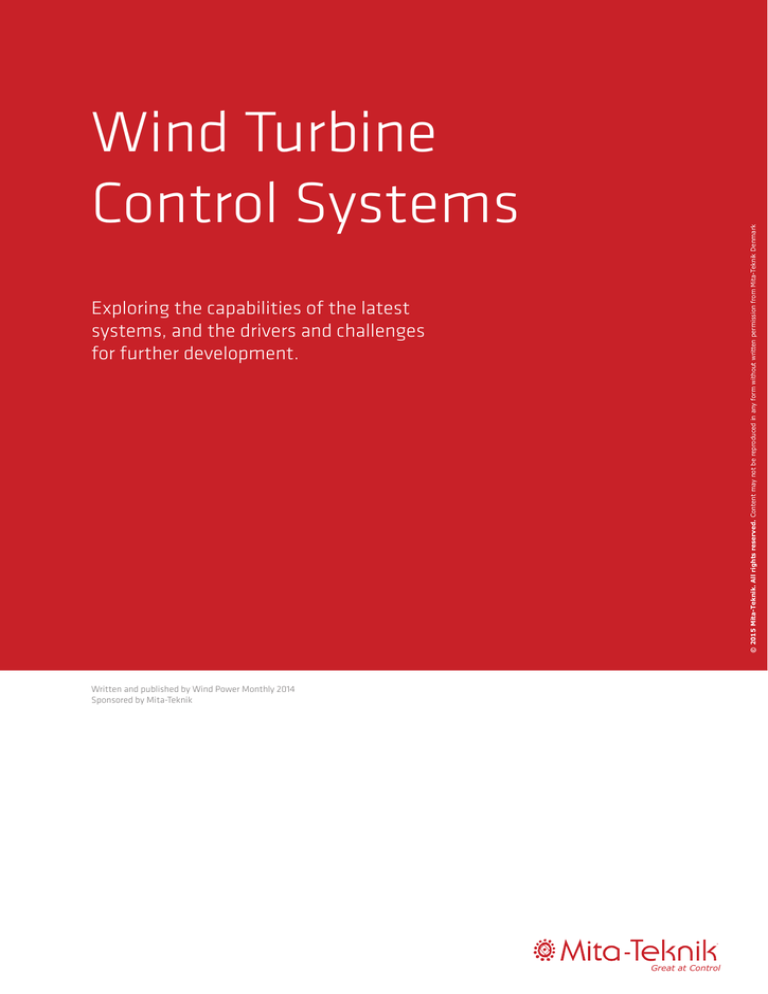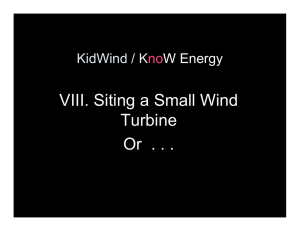
© 2015 Mita-Teknik. All rights reserved. Content may not be reproduced in any form without written permission from Mita-Teknik Denmark
Wind Turbine
Control Systems
Exploring the capabilities of the latest
systems, and the drivers and challenges
for further development.
Written and published by Wind Power Monthly 2014
Sponsored by Mita-Teknik
®
Great at Control
2
Wind Turbine Control Systems
Exploring the innovations, challenges and future potential of
the systems that ensure real-time reliable, efficient and safe
functioning of wind turbines.
Wind Turbine Control Systems
The first wind turbine control systems were relatively simple.
Used on stall-pitch, fixed-speed turbines, little more was
required of them than starting the blades, stopping them
and turning the nacelle into the wind. Turbines used today for
commercial-scale wind farms are variable-speed, variable pitch
and are considerably larger than those seen in the industry’s
early days. The control systems have also grown much more
complex as wind turbines themselves have evolved. As a trend
towards larger rotors and higher megawatt ratings continues,
and pressure to drive down the cost of energy gives no sign of
easing, further advances in control systems will be critical.
Control systems are essential for the reliable, efficient and safe
functioning of wind turbines. They are fitted with sensors that
gather data on wind conditions, power generation, vibration,
lubricants, rotor and generator speed and other parameters,
which are then sent for analysis to a computer.
software upgrades — are used to tell components known as
actuators how to respond to that input in real time, perhaps
putting in a request to change the pitch angle of a blade or
setting off a braking system when the wind is blowing too
strongly. Information updates are sent several times a second.
Market Demand
Turbine control systems are seen as an important contributor
to lowering the cost of energy, a drive that has been gaining
momentum as subsidies are rolled back and higher-cost
offshore wind develops. Reducing the cost of energy is partially
a function of maximizing power production (and revenue) over
the lifetime of a turbine, something that turbine control systems
can do by altering the pitch of the blade and maximizing wind
capture. It also involves balancing performance with technology
investments and other production costs, including the wear and
tear on the turbine.
Insight garnered from the turbine control system is critical to
understanding whether an individual turbine is performing at
its best. Turbine owners are looking for control systems that
are easy to use and include diagnostics and troubleshooting
characteristics that allow those in the field to understand the
reasons for eventual problems and fix them quickly. They are
also looking for flexibility. Turbine manufacturer GE is receiving a
growing number of requests from customers seeking increased
control-system functions that take into account site-specific
characteristics or requirements such as wildlife mitigation.
Key Forces and Controls
Control system monitor and respond to changing forces, optimizing
performance.
Algorithms — which are closely guarded business secrets of
the control-system manufacturers and are updated through
Grid operators are also putting greater demands on turbine
control systems to guarantee the grid operates safely and
efficiently, ensuring that the power generated from wind farms
has the correct frequency and voltage, particularly as wind power
begins to represent a significant portion of power production in
some countries. These requirements must all be satisfied.
®
Great at Control
3
Wind Turbine Control Systems
Exploring the innovations, challenges and future potential of
the systems that ensure real-time reliable, efficient and safe
functioning of wind turbines.
And while ensuring safety has always been a key task of control
systems, the fact that turbines installed offshore are immense,
and set to get even larger, means that safety will most certainly
remain a key driver for market demand.
Cutting the Cost of Energy
Using the control system to increase optimization can cut costs significantly.
Source: Mita-Teknik
Recent Developments
In the last twelve months, the market has focused on windturbine optimization possibly more intensely than ever before,
with control systems a key part of this process. Competition
among control system suppliers has increased, as have the
requirements that wind turbines must satisfy. Optimization
often involves marrying control-system improvements with
other changes to the turbine, according to Mita-Teknik.
When it comes to control systems for individual wind turbines,
load control has been the clear focus of engineers’ recent efforts.
Reducing fatigue loads and mitigating extreme loads can help
reduce damage to components and lengthen a turbine’s lifetime.
Money can be saved by catering for lower load levels on a turbine.
to optimize the design elements of the turbine and the control
system.
More recent additions to capabilities, such as individual blade
pitch control, are an increasingly common offering by controlsystem providers. With large blades often encountering
substantial wind-speed differences and structural loads from top
to bottom positions, individual pitch control is now seen as a key
method for better managing and balancing these asymmetries.
The technology for individual pitch control has moved past the
first-generation stage, although there are still barriers to their
widespread use by turbine manufacturers, who are concerned
about strains on actuators, according to Bill Leithead, director of
the industrial control centre at the University of Strathclyde in
the UK. As turbine sizes continue to increase, however, and the
load reduction benefits increase, a tipping point will be reached,
at which it will make economic sense for this technology to
become a standard offering, Leithead believes.
One development now standard on newer turbines that users
cite as beneficial is the ability for individual turbines to de-rate
— or operate below nominal rated capacity — when a temperature
limit is reached or exceeded inside the turbine. Now, for example,
a turbine with 2MW rated capacity may operate at 1MW until
the problem is resolved and the machine can resume operating
normally. In the past, this situation would have caused the turbine
to shut down completely, with a greater loss of power output.
Another area in which progress has been made is in allowing wind
turbines to continue operations even in adverse, high-speed
winds of around 25 metres a second. This is an improvement
on previous systems that would have required the turbine
shut down for safety reasons. Enercon, for example, is one
manufacturer known for its “storm control” feature, part of the
control system.
It is therefore increasingly important to use load-analysis data
®
Great at Control
4
Wind Turbine Control Systems
Exploring the innovations, challenges and future potential of
the systems that ensure real-time reliable, efficient and safe
functioning of wind turbines.
Reliable systems are constructed through feedback, they argue.
Improvements for Older Models
While the most advanced control systems are found on new
turbines, there is also robust demand for system upgrades
for older machines. Wind farm owner Enel Green Power
routinely upgrades software improvements made available
by turbine manufacturers. The company has around 4,000
turbines, of which a fair share are older than five years.
Depending on site conditions, this exercise can result in an
annual increase in power output over the lifetime of the
turbine in the order of 1% to 5%, according to Santiago Rubira
Dominguez, head of operations and maintenance, before any
control system or turbine hardware adjustments are made.
The best way to lower the cost of energy, however, is by
introducing new algorithm designs and other advanced
control features during the turbine design stage. By
integrating the design of the control system more closely
with the turbine, the cost of energy can be reduced by as
much as 10%, according to some control system providers.
Reliability Issues
Given the complexity of turbine control systems and the number
of parts involved, it is not surprising that they are not fail proof.
Indeed, some industry commentators say that reliability is the
biggest challenge facing turbine control systems. This criticism is
often followed up with a request for the wind industry to better
pool resources to understand the reasons for failures.
Turbine Growth
The bigger the turbine, the greater the importance of load reduction.
Availability, one measure of how reliable a turbine is, has improved
on an industry-wide basis, and control systems can move this
further along again, believes manufacturer GE’s engineering
leader for electrical and controls, Minesh Shah. Modern control
systems can increasingly explore de-rating strategies that allow
production of a turbine, and, believes Shah, greater opportunities
are available through improvements in the control-systems
hardware to reduce failures from electronics and sensors.
In addition to robust hardware, one important component of
reliability lies in how a control system is programmed. This may
prompt a trend away from commercial operating systems and
software applications, which may be more fragile, and towards
industrial products.
®
Great at Control
5
Wind Turbine Control Systems
Exploring the innovations, challenges and future potential of
the systems that ensure real-time reliable, efficient and safe
functioning of wind turbines.
Technology Forecast
Going forward, the general consensus is that one key area for
the advancement of control systems technology will be in the
field of sensors, which feature throughout the turbine, feeding
information through to the control system. For example, better
sensors are needed to handle the loads that will accompany larger
rotors and megawatt ratings and allow wind-farm operators to
take a more proactive approach to operating a turbine.
Remote-sensing devices such as lidar (light detection and
ranging) and sodar (sound detection and ranging) continue to
be costly but, as prices drop, are increasingly seen as becoming
viable technologies. With turbine-mounted lidar sensors, for
example, it is believed that it can be possible to reduce the load
quite radically, by as much as 15-20%.
Researchers are also looking at control-system features that
move away from pitch control. One possibility being studied is
that of positioning smallish-sized individual flaps, not dissimilar
to those found on aircraft wings, on the trailing edge of the
blades as a means for load mitigation.
To continue on the path of cost reduction, sensors, algorithms
and actuators — which can be seen as the eyes and ears, the
brain, and the arms and legs of the turbine’s control system —
must all evolve. Developments in one area may very well lead
to progress in others, believe some industry experts. As new
and better information is provided by sensors, that can up
opportunities to better manage algorithms. Actuators with a
faster response speed can help to better manage the delicate
balancing act between performance and load.
®
Great at Control
6
Wind Turbine Control Systems
Exploring the innovations, challenges and future potential of
the systems that ensure real-time reliable, efficient and safe
functioning of wind turbines.
A selection of Control Systems on the Market
Company
Lead Control Product
Key Features
AMSC
wtECS Electrical Control
Systems
Control systems feature AMSC’s proprietary PowerModule power
converters
Bachmann electronic
M1 controller,
automation system
Include ColdClimate modules for applications in demanding
climactic conditions, grid measuring module that can be integrated
into controller system
Beckhoff Automation
Control technology
PC- and EtherCAT-based control technology is characterised by
variety of hardware and software interfaces
DEIF Wind Power
Technology
AWC500 controller
Software technology relies on opensource Linux, PLC Link feature
supports control strategy development
kk-electronic
C System
Modular software allows for differentiation of wind turbine
Mita-Teknik
WP4200 control system
platform
Onboard condition monitoring system, grid quality analyser, wellsuited for individual pitch control
Moog
Pitch control systems
Features include TÜV-certified Moog Pitch Servo Drive feathering
control for blades
SSB Wind Systems
Pitch control systems
Proprietary UniFlex Pitch system, which can be used in roughly 85%
of all wind turbines, independent of manufacturer
®
Great at Control





